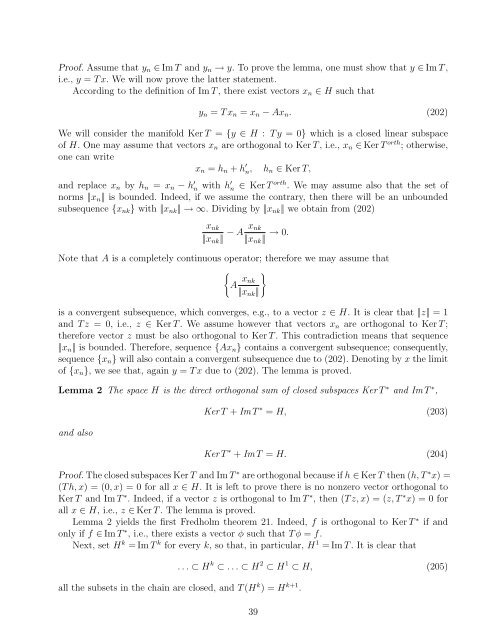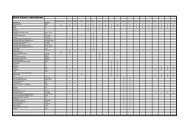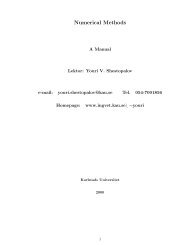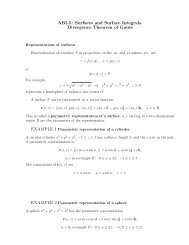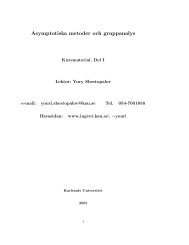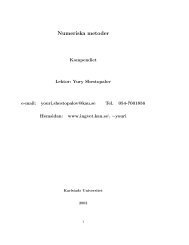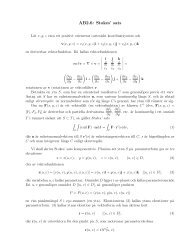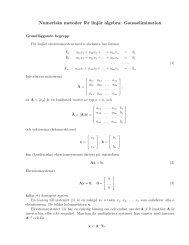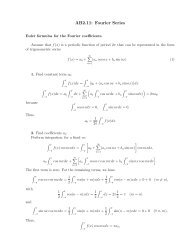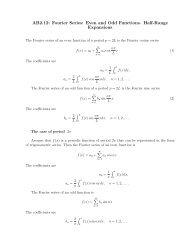Create successful ePaper yourself
Turn your PDF publications into a flip-book with our unique Google optimized e-Paper software.
Proof. Assume that y n ∈ Im T and y n → y. To prove the lemma, one must show that y ∈ Im T ,i.e., y = T x. We will now prove the latter statement.According to the definition of Im T , there exist vectors x n ∈ H such thaty n = T x n = x n − Ax n . (202)We will consider the manifold Ker T = {y ∈ H : T y = 0} which is a closed linear subspaceof H. One may assume that vectors x n are orthogonal to Ker T , i.e., x n ∈ Ker T orth ; otherwise,one can writex n = h n + h ′ n, h n ∈ Ker T,and replace x n by h n = x n − h ′ n with h ′ n ∈ Ker T orth . We may assume also that the set ofnorms ||x n || is bounded. Indeed, if we assume the contrary, then there will be an unboundedsubsequence {x nk } with ||x nk || → ∞. Dividing by ||x nk || we obtain from (202)x nk||x nk || − A x nk||x nk || → 0.Note that A is a completely continuous operator; therefore we may assume that{A x }nk||x nk ||is a convergent subsequence, which converges, e.g., to a vector z ∈ H. It is clear that ||z|| = 1and T z = 0, i.e., z ∈ Ker T . We assume however that vectors x n are orthogonal to Ker T ;therefore vector z must be also orthogonal to Ker T . This contradiction means that sequence||x n || is bounded. Therefore, sequence {Ax n } contains a convergent subsequence; consequently,sequence {x n } will also contain a convergent subsequence due to (202). Denoting by x the limitof {x n }, we see that, again y = T x due to (202). The lemma is proved.Lemma 2 The space H is the direct orthogonal sum of closed subspaces Ker T ∗ and Im T ∗ ,and alsoKer T + Im T ∗ = H, (203)Ker T ∗ + Im T = H. (204)Proof. The closed subspaces Ker T and Im T ∗ are orthogonal because if h ∈ Ker T then (h, T ∗ x) =(T h, x) = (0, x) = 0 for all x ∈ H. It is left to prove there is no nonzero vector orthogonal toKer T and Im T ∗ . Indeed, if a vector z is orthogonal to Im T ∗ , then (T z, x) = (z, T ∗ x) = 0 forall x ∈ H, i.e., z ∈ Ker T . The lemma is proved.Lemma 2 yields the first Fredholm theorem 21. Indeed, f is orthogonal to Ker T ∗ if andonly if f ∈ Im T ∗ , i.e., there exists a vector φ such that T φ = f.Next, set H k = Im T k for every k, so that, in particular, H 1 = Im T . It is clear that. . . ⊂ H k ⊂ . . . ⊂ H 2 ⊂ H 1 ⊂ H, (205)all the subsets in the chain are closed, and T (H k ) = H k+1 .39


